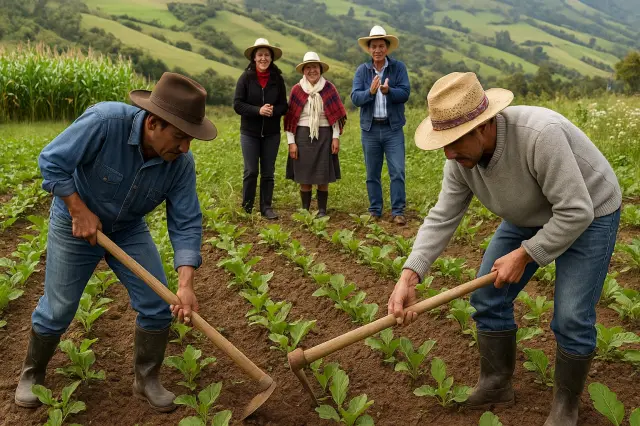The value of peasant traditions in Colombia
Rural traditions in Colombia are one of the most important pillars of the country's cultural identity. Despite the social and technological changes of the 21st century, many of these customs remain alive in towns, villages, and rural regions, passed down from generation to generation.
The Colombian countryside not only contributes to the economy with its agricultural production, but also safeguards ancestral knowledge, practices of solidarity, and ways of life that reflect the cultural richness of each region.
In this article, we'll explore the main Colombian peasant traditions, how they've endured over time, and why they remain so important today.
Main Colombian peasant traditions that still survive
1. Community work or “minga”
The minga is an ancient practice of collective work in which farmers gather to perform common tasks such as planting, harvesting, building homes, and maintaining roads.
It represents solidarity and community unity.
In exchange for help, the hosts offer traditional food and music.
Although modernity has transformed many rural dynamics, the minga remains prevalent in several Andean regions.
2. Lunar calendar agriculture
In many villages, farmers still sow and harvest according to the phases of the moon.
It is believed that the waxing moon favors the growth of plants.
The full moon is related to the good development of fruits and vegetables.
These beliefs are part of ancestral agricultural knowledge that still guides small farmers.
3. Patronal and religious festivals
Rural life is deeply linked to spirituality.
Each town celebrates its patron saint with masses, processions, music, and fairs.
These festivities are occasions to strengthen community unity.
In coffee-growing regions, for example, festivals in honor of the Virgin of Carmen or San Isidro Labrador, patron saint of farmers, are common.
4. Barter as a form of exchange
Although money is the main means of transaction, bartering is still practiced in some towns.
Products such as coffee, panela, cassava, beans and handicrafts are exchanged.
This practice strengthens relationships between farming families and helps maintain balance in times of scarcity.
5. The oral transmission of stories and legends
On country nights, stories around the campfire remain a living tradition.
There are myths and legends such as La Llorona , El Mohán or La Patasola .
These narratives convey values and explain natural phenomena from the popular worldview.
Today they remain part of the cultural identity of children and adults in rural areas.
6. Country music and traditional dances
The carranga, the bambuco, the pasillo and other genres continue to be heard in villages and towns.
At family gatherings and community celebrations, country music accompanies daily life.
Traditional dances reinforce the sense of belonging and are taught to new generations.
7. Typical meals prepared with local products
Country cuisine reflects the use of ingredients grown in the region itself.
Corn arepas, mazamorra, sancocho, and sugarcane drinks like chicha are examples of this tradition.
These recipes not only nourish the body, but also preserve the cultural memory of the Colombian countryside.
Importance of keeping peasant traditions alive
Peasant traditions are not mere customs, but expressions of cultural identity and resistance. Keeping them alive means:
Protect the country's historical memory and cultural diversity.
Strengthening regional identity in the face of globalization.
Promote sustainable agricultural practices and community coexistence.
Promote cultural tourism in rural areas of Colombia.
Tourism and rural traditions in Colombia
In recent years, rural tourism has gained momentum in the country, as more and more people seek authentic experiences. Many national and international visitors enjoy:
Participate in mingas or harvests.
Learn about traditional coffee, cocoa, and panela crops.
Try typical peasant dishes.
Listen to oral stories and enjoy local festivals.
